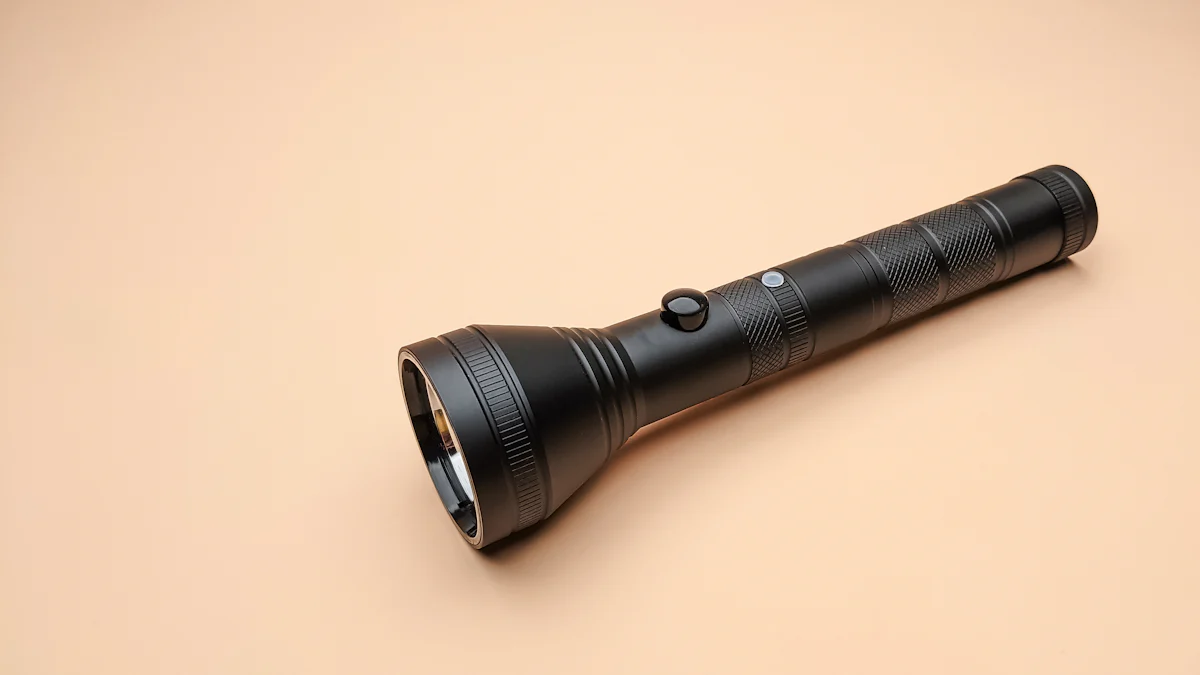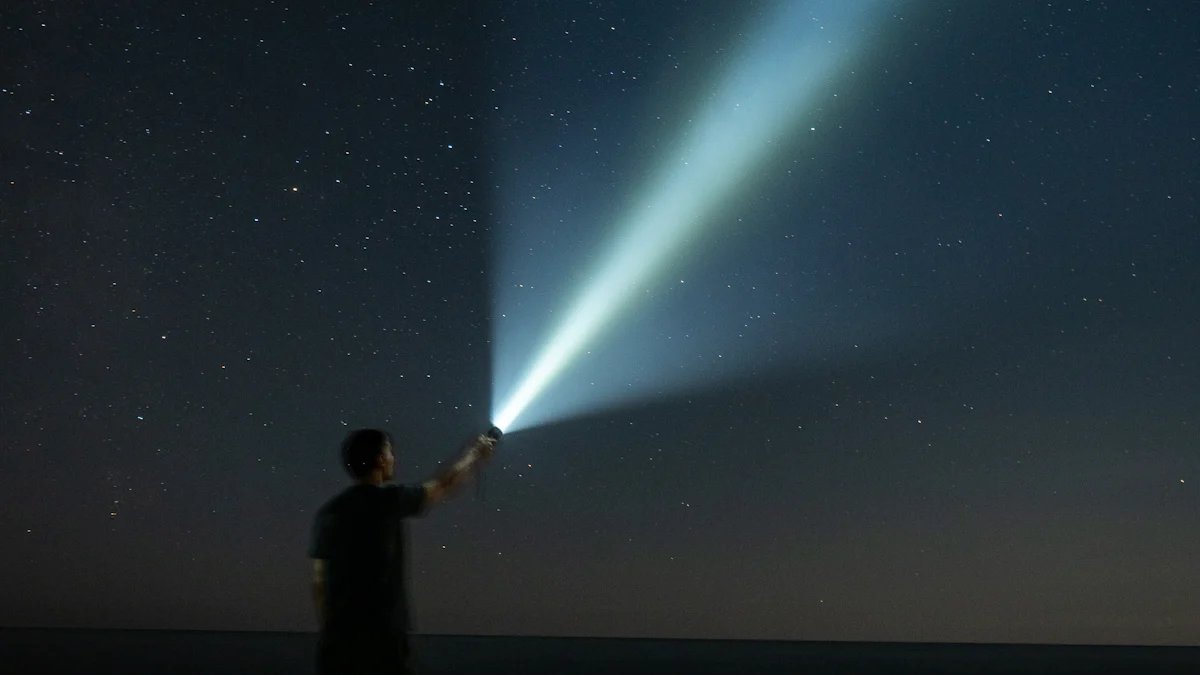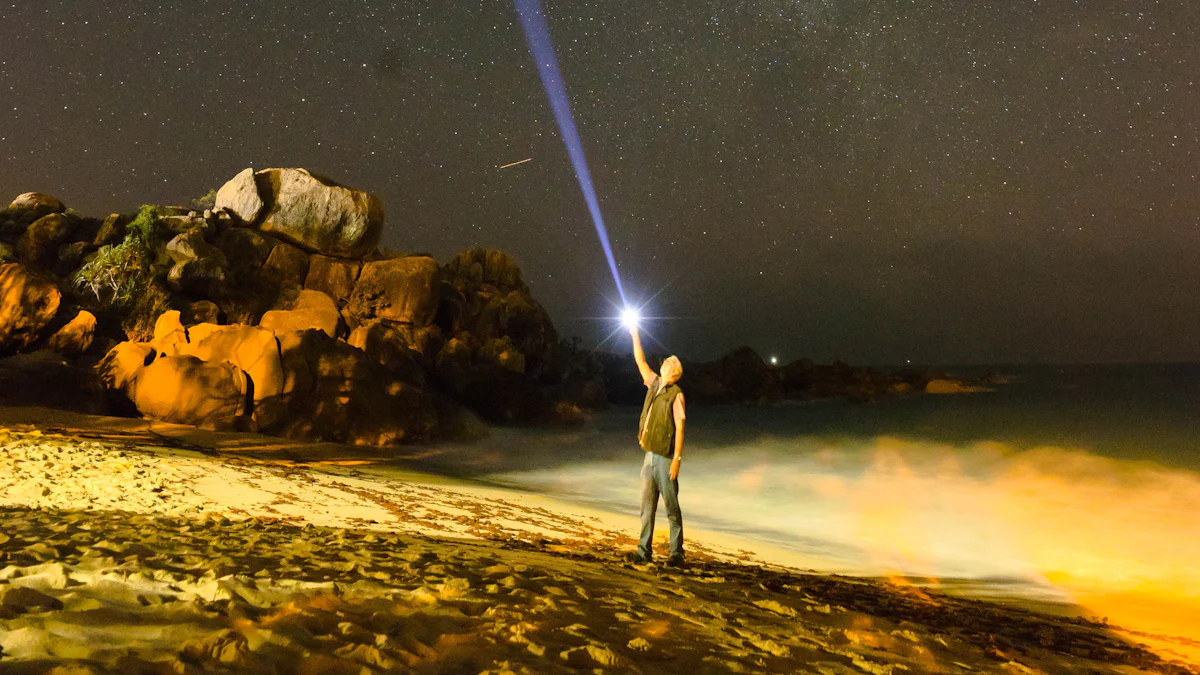How to Choose the Right Flashlight Brightness

Choosing the right flashlight can make your life so much easier. Whether you're camping, fixing something in a dark corner, or just walking your dog at night, having the right amount of light is essential. But how do you know which flashlight is best for your needs? That’s where lumens come in. Lumens measure how bright a flashlight is, helping you decide if it’s powerful enough for your task. Matching the brightness to your activity ensures you’re not left in the dark—or wasting energy on too much light. It’s all about providing the right amount of light for the job.
Key Takeaways
Lumens measure how bright a flashlight is. More lumens mean brighter light, helping you pick the best flashlight.
For daily use, pick flashlights with 10-150 lumens. This gives enough light for reading or walking without being too bright.
Choose the right beam for your task. Floodlight beams light up wide areas, while spotlight beams reach far distances.
Think about battery life and power type. Rechargeable flashlights save money and help the environment. Disposable ones are handy in emergencies.
Check for strong features like water and impact resistance. A good flashlight should handle tough situations and work well every time.
What Are Lumens and How Do They Impact Flashlights?
Understanding Lumens
Definition and role in measuring brightness.
When you’re shopping for a flashlight, you’ll often see the term "lumens" on the packaging. But what does it mean? Lumens measure the total light output from a source. Think of it as the amount of visible light a flashlight produces. The higher the lumens, the brighter the light. For example, a flashlight with 100 lumens is great for simple tasks like finding your keys, while one with 1000 lumens can light up a large outdoor area.
Lumens are essential because they help you compare flashlights and decide which one suits your needs. Whether you’re looking for a flashlight for camping or household use, knowing how many lumens you need can save you time and money.
Why lumens are essential for flashlight selection.
Understanding lumens is key to choosing the right flashlight. They give you a clear idea of how much light you’ll get. However, lumens alone don’t tell the whole story. Other factors, like beam type and battery life, also play a role. For instance, a flashlight with a high lumen output might drain its battery faster. So, it’s important to balance brightness with practicality.
Common Misunderstandings About Lumens
Brightness vs. beam distance.
Many people think brightness and beam distance are the same, but they’re not. Brightness refers to the total light output, while beam distance shows how far the light reaches. A flashlight with fewer lumens but a focused beam can illuminate farther than one with more lumens but a wide beam. It’s like comparing a spotlight to a floodlight.
Why more lumens aren’t always better.
It’s easy to assume that more lumens mean a better flashlight, but that’s not always true. High-lumen flashlights can drain batteries quickly, making them less practical for long-term use. Plus, too much brightness can be overwhelming in close spaces. A flashlight with moderate lumens and a well-designed beam is often more effective. Think of it like a fire hose: the lumens are the water, but the nozzle (or beam focus) determines how the water is sprayed.
If you’re wondering how to decide the lumens for your needs, consider the activity and environment. A lumen chart can also help you compare lumens settings in different lighting areas.
How Many Lumens Do I Need for Everyday Flashlight Use?
Recommended Lumen Range
10-150 lumens for household tasks.
For everyday tasks around the house, you don’t need a flashlight with extreme brightness. A flashlight with 10-150 lumens is perfect for simple activities like reading, walking your dog, or finding something in a dark corner. This range provides enough light without being overwhelming or draining the battery too quickly.
Flashlights in this range are also great for power outages. A flashlight with 100-150 lumens can illuminate up to 80 meters, making it ideal for navigating your home during a blackout. If you’re looking for something lightweight and easy to carry, flashlights with 1-250 lumens are a solid choice for basic household needs.
Examples: reading, walking the dog, or finding items in the dark.
Imagine you’re reading a book before bed or searching for your keys under the couch. A flashlight with lower lumens, like 10-50, is all you need. For outdoor tasks like walking your dog at night, a flashlight with 100 lumens provides enough light to see your path without disturbing others. These flashlights are versatile and practical for everyday use.
Key Features for Everyday Flashlights
Compact size and portability.
When you’re using a flashlight daily, portability matters. Compact flashlights are easy to carry in your pocket or bag, so you’ll always have light when you need it. Look for models that are lightweight but durable, often made from materials like aluminum.
Battery life for frequent use.
Frequent use means you’ll want a flashlight with a long battery life. Some models can last over 100 hours, depending on the brightness setting. Rechargeable batteries are a great option for saving money and reducing waste. A flashlight with adjustable brightness settings can also help conserve battery life by letting you switch to lower lumens when full power isn’t necessary.
Tip: Choose a flashlight with water resistance and impact resistance for added durability. Everyday flashlights often face drops or exposure to moisture, so these features can make a big difference.
How Many Lumens Are Best for Outdoor Activities?

Recommended Lumen Range
200-600 lumens for camping, hiking, or night walks.
When you're heading outdoors, you need a flashlight that provides just the right amount of light for your activities. For general camping or hiking, flashlights between 100 to 400 lumens work well. They’re perfect for tasks like setting up a tent, reading a map, or walking around the campsite. If you’re planning longer hikes or exploring trails at night, aim for a flashlight with 200-600 lumens. This range offers enough brightness to illuminate your path without draining the battery too quickly.
600-1000+ lumens for search-and-rescue or hunting.
For more demanding outdoor activities like search-and-rescue missions or hunting, you’ll need higher lumens. Flashlights with 600-1000+ lumens provide powerful illumination, making it easier to spot objects or navigate through dense forests. These flashlights can light up large areas and offer excellent beam distance, which is crucial when visibility is limited. If you’re in extreme conditions, a flashlight with higher lumens ensures you won’t miss a thing.
Key Features for Outdoor Flashlights
Beam type: flood vs. spotlight.
The type of beam your flashlight produces can make a big difference outdoors. A floodlight beam spreads light over a wide area, making it ideal for campsite tasks or group activities. On the other hand, a spotlight beam focuses light into a narrow, long-distance path. This is great for navigating trails or spotting landmarks in the distance. Many outdoor flashlights let you switch between these modes, giving you flexibility for different situations.
Durability and weather resistance.
Outdoor adventures can be tough on your gear, so your flashlight needs to handle the elements. Look for models with an IP68 waterproof rating, which ensures they can withstand rain, dust, and even accidental drops. For example, the Fenix PD40R V3.0 flashlight is both waterproof and dustproof, making it a reliable choice for any outdoor activity. A durable flashlight keeps you prepared, no matter the weather or terrain.
Tip: Choose a flashlight with long battery life and multiple brightness modes. These features help you adapt to changing conditions and conserve power during extended trips.
Flashlights for Professional and Tactical Use

Recommended Lumen Range
1000+ lumens for law enforcement, security, or construction.
When it comes to professional or tactical use, you need a flashlight that delivers serious power. Flashlights with 1000 lumens or more are ideal for tasks like law enforcement, security patrols, or construction work. These high-performance flashlights provide intense brightness, ensuring you can inspect large areas or work in low-light conditions with ease.
Tactical flashlights typically range from 1200 to 2500 lumens, offering the strongest portable beam for demanding situations. Whether you're part of a search-and-rescue team or working in military operations, these tools are designed to handle the toughest jobs. They can even cause temporary blindness when directed at someone’s eyes, making them a non-lethal self-defense option.
Examples: inspecting large areas or tactical operations.
Imagine you're patrolling a construction site at night or navigating a dense forest during a rescue mission. A flashlight with 1000-3000 lumens ensures you have the light you need to see every detail. Hunters and advanced campers also rely on these handheld lights for their powerful output and ability to disorient potential threats.
Key Features for Professional Flashlights
Adjustable brightness settings.
Professional tasks often require flexibility. A flashlight with adjustable brightness settings lets you switch between high output for maximum visibility and lower settings to conserve battery life. This feature is especially good for a flashlight used in long shifts or extended operations. You can adapt the light to your specific needs without compromising performance.
Strobe or SOS modes for emergencies.
In critical situations, strobe and SOS modes can be lifesavers. Strobe mode enhances visibility in low-light conditions and can disorient potential threats, making it a valuable self-defense tool. SOS mode, on the other hand, emits a distinct Morse code pattern to signal for help. For example, during a boating trip, an SOS mode can attract nearby vessels, ensuring rescue. These features make tactical flashlights indispensable for emergencies, whether you're on land or at sea.
Tip: Look for a tactical flashlight with a durable design and rechargeable batteries. The best rechargeable flashlight review often highlights models with long-lasting power and rugged construction, ensuring reliability in any situation.
Other Factors to Consider When Choosing Flashlight Brightness
Beam Type
Floodlight for wide coverage
If you need to light up a large area, a floodlight beam is your best friend. It spreads light over a wide angle, often exceeding 45 degrees and reaching up to 120 degrees. This makes it perfect for tasks like working in dark spaces, lighting up a campsite, or even illuminating your backyard. Floodlights create soft, non-directional light, which reduces harsh shadows and provides even coverage. Whether you're setting up a tent or hosting an outdoor gathering, a floodlight beam ensures you can see everything clearly.
Spotlight for focused, long-distance illumination
Spotlights, on the other hand, focus light into a narrow beam, usually under 45 degrees. This concentrated light is ideal for long-distance visibility. If you're hiking at night or searching for something far away, a spotlight beam helps you see clearly without wasting light. Spotlights are also great for tactical flashlight users who need precision, like hunters or law enforcement professionals. Choosing the right beam type depends on your activity, so think about whether you need wide coverage or focused illumination.
Battery Life and Power Source
Rechargeable vs. disposable batteries
The type of battery your flashlight uses can impact its performance and convenience. Here's a quick comparison:
Battery Type | Pros | Cons |
|---|---|---|
- Bright lumen output | - Larger size | |
AA Flashlights | - Lightweight and compact | - Higher ongoing costs |
Rechargeable batteries are great for frequent use and high-lumen flashlights, while disposable ones are better for occasional use or emergencies.
How brightness affects battery consumption
Higher brightness levels drain batteries faster. A flashlight with adjustable brightness settings can help you conserve power when full light output isn’t necessary. For example, using a lower setting while reading or walking can extend battery life significantly. If you’re planning extended use, consider a flashlight with a long-lasting battery or a rechargeable option.
Environmental Conditions
Weatherproofing for outdoor use
Outdoor adventures can be unpredictable, so your flashlight needs to handle tough conditions. Look for models with a high IPX rating for water resistance. This ensures your flashlight works even in heavy rain or wet environments. Durable materials like aluminum also protect against drops and rough handling.
Temperature resistance for extreme environments
If you’re heading into extreme heat or cold, choose a flashlight designed for temperature resistance. Some flashlights maintain performance in freezing conditions, while others handle high heat without issues. This feature is especially important for mountaineers, campers, or anyone working in harsh climates. A suitable flashlight should perform reliably, no matter the environment.
Tip: Always check the flashlight’s specifications for durability and environmental resistance before making a purchase.
Choosing the right flashlight doesn’t have to be complicated. Understanding lumens helps you pick the perfect brightness for your needs. Whether you’re reading, hiking, or working in extreme conditions, matching the light output to your activity ensures efficiency and comfort. Remember, higher lumens aren’t always better—balance brightness with battery life for practical use.
Don’t forget to think about beam type, durability, and waterproofing. A reliable flashlight should handle tough conditions and provide the right light for the job. With these tips, you’ll find a flashlight that’s ready for anything.
FAQ
What is the best flashlight brightness for emergencies?
For emergencies, choose a flashlight with at least 200 lumens. It provides enough light to navigate in the dark or signal for help. A model with strobe or SOS modes is even better for attracting attention during critical situations.
Can I use a high-lumen flashlight indoors?
Yes, but be cautious. High-lumen flashlights can be too bright for small spaces and may cause glare. For indoor use, stick to 10-150 lumens. This range is perfect for tasks like finding items or lighting up a room during a power outage.
How do I know if my flashlight is waterproof?
Check the IP rating on the flashlight. An IPX4 rating means it’s splash-resistant, while IPX7 or higher ensures it can handle submersion. If you’re using it outdoors, pick a model with at least IPX6 for reliable weatherproofing.
What’s the difference between rechargeable and disposable flashlights?
Rechargeable flashlights save money over time and are eco-friendly. They’re great for frequent use. Disposable flashlights are lightweight and ideal for emergencies when recharging isn’t possible. Choose based on how often you’ll use the flashlight and your convenience.
How can I extend my flashlight’s battery life?
Use lower brightness settings when full power isn’t needed. Turn off the flashlight when not in use. Rechargeable models often have longer-lasting batteries, so consider switching to one if you use your flashlight regularly.
See Also
Selecting The Perfect Headlamp Flashlight For Your Needs
Finding The Ideal High Power Flashlight For You
A Complete Guide To Selecting The Best Home Flashlight
Understanding Flashlight Lumens: Your Ultimate Brightness Resource
